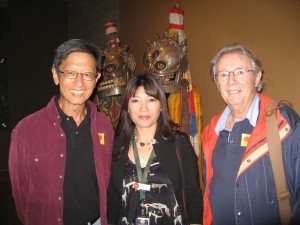Tell me a story …
How many times have we heard young children utter those words? Not just young people but people of all ages enjoy listening to stories and telling them too. We explore and question history, culture, as well as collective and personal identity through the stories we tell. In many cultures, gifted story tellers are revered as repositories of wisdom, giving voice to the collective memory of a people. But within the context of a collective framework, there are stories of individuals and each one of these stories reflects a sense of personal growth, a unique sense of destiny.
Personal narrative was the focus of a panel discussion held at Baruch College, East-West Identity: Journeys & Transformation, on Tuesday, October 26th. The discussion was used as a kick off event for a new and exciting collaboration between the Rubin Museum of Art and Baruch College, and I was delighted to be able to help coordinate and attend the event.
Twelve hundred Baruch Freshmen took seats in Mason Hall one afternoon to listen to a distinguished panel of discussants reflect on the power of personal narrative as a means for exploring cross-cultural identity, a topic explored frequently at the Rubin Museum. The panel was convened in honor of Charles Li, Dean Emeritus of the Graduate Division of the University of California, Santa Barbara, and professor of Linguistics. Along with Dr. Li, the panel included Stan Altman, Director of the American Humanics Program at Baruch, who served as moderator. Dr. Altman was joined by Katrin Hansing, Associate Professor of Black and Hispanic Studies at Baruch, Tashi Chodron, founder of Voices of Tibet: Tibetan Oral History Project, and Bruce Payne, Executive Director of the Shelly and Donald Rubin Foundation.
Over the summer of 2010, all Baruch Freshman were asked to read Dr. Li’s book, The Bitter Sea: Life in a China Before the Time of Mao. The book is riveting tale of Dr. Li’s childhood in China from 1940 to 1960. After two decades of mind-reeling emotional and physical hardships, Charles Li evolves from a dutiful Chinese son, yearning for his harsh and punitive father’s love and approval, to Charles Li, an independent Chinese American, who, after winning a scholarship to attend Bowdoin college in the United States, would later became a Professor of Linguistics at the University of California. It is a remarkable story.
Although the specific details of Dr. Li’s narrative are remarkable, the underlying issues of his story address universal themes: How do we honor tradition, communal and familial, while developing a personal sense of identity? When, if ever, should we reject tradition when it no longer supports with who are or the person we hope to become?
After a warm round of applause, Dr. Li enthusiastically explored these questions with the Baruch students. He emphasized that he was able to endure the hardships of his childhood, such as living in a disease-ridden slum outside Nanjing (Peking) because of the close friendships he forged with other young boys who encouraged him to be active, curious, and fearless. His courageous peers planted the seed of rebellion: ten years later, Dr. Li broke free of the traditional Chinese Confucian model, one that emphasizes obeying one’s parents, by attending college in the U.S. and leaving his family and life in China behind.
Dr. Li’s words were echoed by Katrin Hansing, who encouraged the Baruch students to think about their personal stories or narratives as continually evolving. Tashi Chodron, who works at the Rubin Museum of Art as a Museum Guide, also explored identity but from the perspective of growing up as a part of the Tibetan refugee community in south India. Bruce Payne shared two poignant stories that illuminated the complex and sometimes contradictory nature of identity. Looking back at his early years, Stan Altman discussed how he sought to bridge different cultures and identities while growing up in the South Bronx with a Greek Orthodox Christian mother and an Eastern European Jewish father.
During the Q & A that followed, one Baruch student posed a question to Charles Li: while a young boy in China, struggling to survive, did he have a sense of how remarkable his story was at the time or was it only through reflection that he understood the full impact of the challenges he overcame to survive?
Both! replied Dr. Li enthusiastically. As a child, he had a sense of his unique destiny unfolding but this understanding was refined and reinterpreted through reflection while writing his book fifty years later. The student’s question triggered an interesting discussion on the part of Dr. Li and the students: when we stop to recall the past, we can’t help but alter it. Our interpretations and perceptions evolve continually.
The next day, after the panel discussion, Dr. Li visited the Rubin Museum with his friend and colleague, David Sprecher, to take a gallery tour with Tashi Chodron. Together, they explored Himalayan art and artifacts in our galleries. Many of these objects have their own remarkable stories to tell, and have traveled to the museum from distant lands, illustrating yet another form of diaspora and identity in motion.
Along with Charles Li, eight hundred Baruch Freshmen will be visiting the museum this semester to see our art and reflect on issues of identity, diaspora, and the power of storytelling. A number of Baruch students have already visited the museum. It’s been a pleasure welcoming them, and we look forward to seeing many more. We hope they will continue to explore the museum, as well as the fascinating nexus of art, identity and storytelling because learning who we are, and who we hope to become is a story that continues to unfold in fascinating ways.





One Response to Tell me a story…